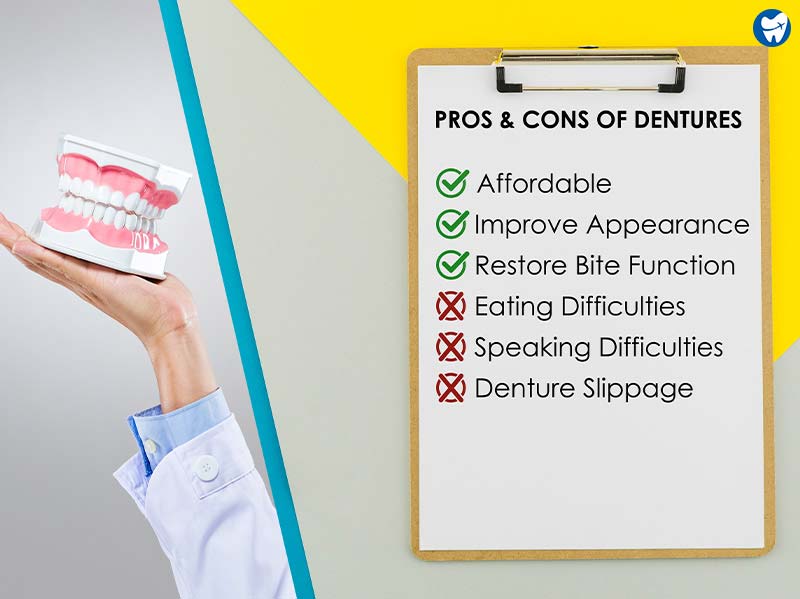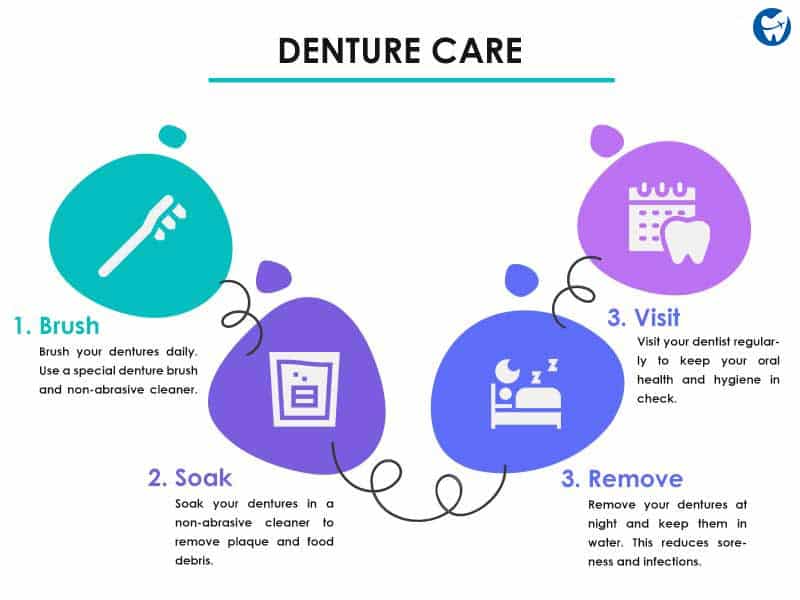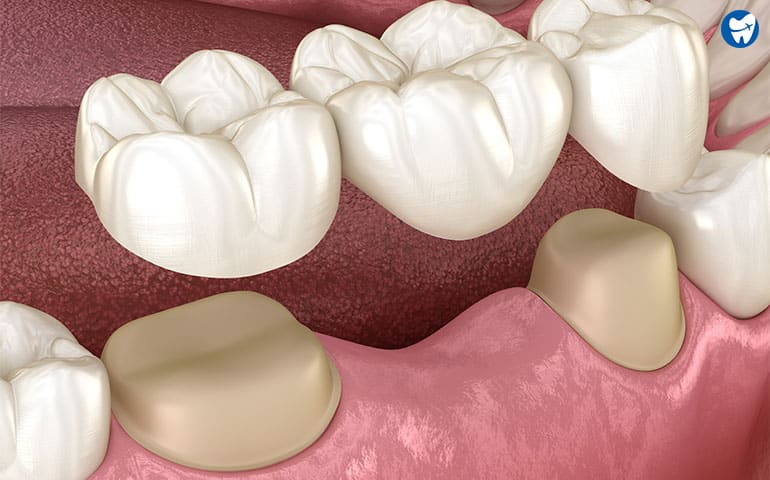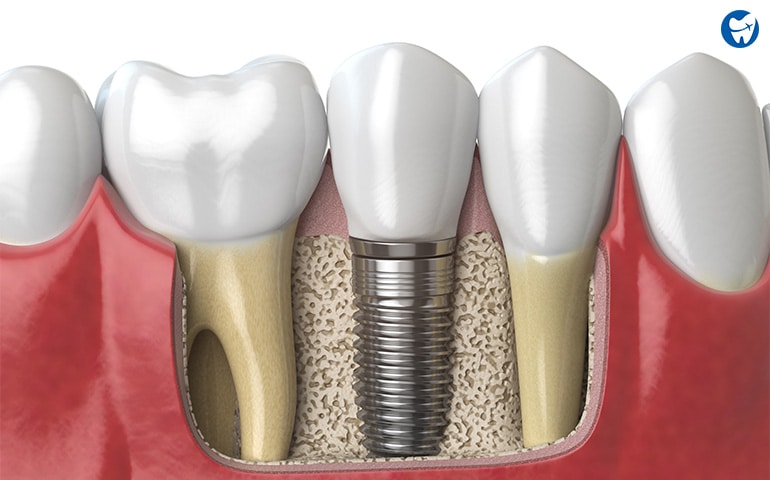A denture is a custom replacement for one or more missing teeth. In the US, prices differ greatly, costing $500 for cheap dentures to $50,000 for implant-supported versions. Dentures can improve the quality of life. In this guide, we explain what they are, your options, and dentures cost.
Removable Complete Denture of the Lower Jaw
Over 36 million Americans miss all teeth and 120 million miss at least one tooth. [1]
What Are Dentures? – Key Points in Sixty Seconds!
- A denture is a custom replacement for one or more missing teeth.
- It restores bite and esthetics while providing improved quality of life.
- They can be either full or partial, and there are various types available.
- Commonly used materials are metal, acrylic resin, and ceramic.
- The materials and processes used depend upon the type of denture needed.
- The cost depends on the type, replacement teeth, and the dentist’s location
- Cheap dentures don’t necessarily mean ‘low quality.’
A denture is an artificial replacement for someone missing one, some, or all of their teeth.
Commonly referred to as ‘false teeth,’ they provide a fully restored smile and improved chewing ability.
However, modern-day dentures offer greater esthetics, comfort, and strength than older versions. [2]
A full or partial denture can also protect any remaining teeth, prevent the face from sagging and improve self-confidence.
But what about the cost of dentures?
These vary significantly depending upon;
- Denture type, the material used
- Additional procedures: tooth extraction or reshapIng bone
- Type of warranty provided
- The location of the dentist providing treatment
Moreover, cheap dentures don’t always mean low quality. However, we’ll delve more into costs later. For now, know that a set of false teeth fits most budgets.
Denture Types and Their Uses
Denture types range from complete to partial and from removable to fixed.
Full, partial, overdentures, and immediate dentures are some of the most commonly used types.
They are held in place using a combination of suction and dental adhesive. They can also be stabilized with dental implants.
Modern-day versions consist of life-like teeth and a gum-colored base generally made from acrylic resin.
Technicians can custom design them to match complexion and skin tone – creating a natural appearance.
In the section below, you find a detailed explanation about each that can help you take your pick.
Full Dentures (Complete)
Complete dentures provide a workable solution for anyone missing all their natural teeth.
Usually, when a patient needs a full mouth restoration, they have exhausted all other options.
They restore bite, speech, and facial symmetry. [3]
You can use it in either the upper or lower jaw or both. Your dentist will customize the denture to fit your arch and match your skin tone.
Removable Complete Denture: Upper & Lower Arch
Partial Dentures
Partial dentures consist of a metal frame or plastic base where replacement teeth are mounted.
They provide a good option for those who still have healthy teeth remaining.
“Partials” are held in place by several methods including, stabilization from natural teeth, dental implants, or metal clasps that grip the natural teeth.
They can either be snapped into implants or removable.
Unlike fixed dental bridges, partials provide a removable option to replace one or more teeth.
While partials are made with acrylic, the resin-base is often strengthened with metal. These are known as metal-cast appliances.
Removable Partial Denture
Implant-Retained Dentures (Overdentures)
An Implant-supported denture provides the convenience of a removable denture for effective cleaning with the security of a fully stabilized appliance.
It also provides added retention for those with bone loss. [4]
Patients can eat, drink, laugh, and talk with confidence without worrying about denture slippage.
They are also known as snap-on teeth because they snap on and off the implant base, making cleaning easy.
While overdentures can be removed at any time, the implants supporting them cannot.
Overdenture
Immediate (Same-Day) Dentures
Sometimes a dentist will need to extract all of a patient’s teeth. Reasons may include:
- advanced decay
- trauma
- severe gum disease
An immediate denture is inserted immediately following surgery whereas permanent appliances are usually fitted somewhere between 3-6 months after tooth extraction.
They are sometimes called same-day healing fixtures and ensure the ongoing stability of the jaw and mouth, improve esthetics and protect extraction sites. [5]
Typically, they consist of a less robust material than most dental appliances and may need to be re-adjusted as your gums heal.
Care also needs to be taken when using them as they are weaker than permanent appliances. Misuse can often lead to future denture problems.
Immediate Dentures
How Much Do Dentures Cost?
You can expect to pay anywhere from $500 – $1,000 for a basic denture. $30,000 to $50,000 for full-mouth, implant-supported fixtures.
Moreover, you can get mid-range ones for $1,000 to $2,500. These prices depend on the number of teeth, the dentist’s location, and the materials used.
Check out the table below for the average prices.
| Type | Average Cost of Dentures (USD) |
| Basic | $500 – $1,000 |
| Mid-Range | $1,000 – $2,500 |
| Premium | $4,000 – $8,500 |
| Partial | $700 – $2,000 |
| Implant-supported | $30,000 – $50,000 |
Basic appliances are cold-cured, meaning that the acrylic isn’t heated. It reduces the production time and cost.
Mid-ranged appliances are better personalized, including natural gum and teeth coloring, while providing a better fit.
Premium appliances represent the highest quality teeth replacements.
The acrylic base-plates represent the exact contours and tone of the gums, while teeth are made from resin or porcelain to mimic both texture and color.
Overdentures are held in place by 4-6 dental implants depending upon where they are in the mouth.
While this may seem expensive, they represent the ultimate missing teeth replacement, providing a permanent solution.
Cost of Tooth Extractions
Other factors that affect the cost of dentures include preparation such as tooth extraction.
Sometimes a dentist will need to remove badly diseased or damaged teeth before fitting a denture.
What About the Average Cost of Dentures in Other Countries?
The US is one of the most expensive countries for dental treatment. [6] Greater expenses are reflected by the high price.
So, where can you go for cheap false teeth? Here’s a breakdown of the prices of dentures abroad:
| Country | Basic to Mid-Range | Premium | Partial | Overdenture* |
| Canada | $1,400 – $2,200 | $4,500 | $1,700 | $29,000 |
| Australia | $990 – $2,500 | $2,800 | $1,900 | $15,000 |
| Mexico | $380 – $480 | $650 | $350 | $10,400 |
| Costa Rica | $450 – $725 | $900 | $800 | $10,650 |
| India | $150 – $250 | $300 | $90 | $3,500 |
*Cost per arch
**Prices above are only a rough informational guide. Final pricing is case-dependent.
Other Factors That Affect the Cost of Dentures
- The location of your dentist – Prices vary from country to country, but also city to city
- Quality of the material used
- Type of guarantee provided
- Any additional procedures like teeth extraction, ridge sculpting, and bone grafting.
Save upto ~80% on quality dentures abroad!
Get FREE quoteWhat’s the Process of Getting Dentures? The Procedure Explained.
Because modern-day appliances are custom-made, there is a step-by-step process to ensure fit, appearance, and function.
This process involves an initial examination, preparation, planning, trial fitting, and final fitting.
Process of Denture Fabrication Video Courtesy: Burst Oral Care
Let’s take a closer look at each stage in more detail.
Examination
Your dentist will carry out a thorough examination of your mouth, including supporting structures.
The process involves:
- Taking a series of x-rays or scan
- Examine the head, neck, and mouth to ensure there are no underlying issues.
Dental Examination
In addition, your dentist will discuss the pros and cons of false teeth. Finally, they will discuss costs, fees, and pricing plans.
Preparation
For partials, it’s vital to complete any cleaning, fillings, or other work (including tooth extraction) before getting dental impressions.
Once all dental work is complete, an impression (mold) or digital scan of your mouth is required.
Manual molding is done over several stages for better accuracy.
Digital scanning, on the other hand, needs just one sitting.
Impression for Dentures
Planning
If you still have remaining teeth, your dentist will plan how your bite will come together.
This process is known as the jaw record and is completed digitally using 3D imaging or manually, using a wax mock-up.
After this, it is sent to the technician for fabrication.
Teeth Setting for Dentures
It is then customized to tailor to your needs and comfort.
Trial Fitting
This stage is called the ‘try-in.’ It provides you with your first experience of the feel and appearance of a denture.
The dentist can also assess how it fits and performs once in the mouth.
During this trial process, it is likely that adjustments are needed.
Other appointments are often required to ensure correct adjustment before fitting.
Denture Trimming Burs
Once you and your dentist are happy, the next appointment is the final fitting.
Final Fitting
After your permanent denture is complete, you will be asked back to the clinic for a final fitting.
The dentist will place the appliance in your mouth, ensuring that it sits comfortably.
Once in position, they will discuss key points like cleaning and aftercare.
Final Denture Trial
Finally, follow-up visits are required to fine-tune your new denture, ensuring it remains comfortable and functional.
What About a Complete Implant-Supported Dental Procedure?
The procedure for implant-retained appliances or ‘teeth in a day’ is slightly different.
Fitting an immediate denture bypasses the trial phase because temporaries are attached immediately after tooth extraction.
This process increases the need for adjustments as the jaw bone is continually healing and changing shape during this period.
 Denture Process
Denture Process
Benefits and Advantages
We talked earlier about the problems with cheap dentures; let’s now talk about the benefits.
Improved Appearance
Dentures help to increase self-confidence while restoring a smile.
They offer an affordable way to replace worn, decayed, or missing teeth while providing vital support for cheeks and lips.
Restored Bite Functionality
Well-made false teeth help improve the speech and bite of those with few or no teeth.
Affordability
Dentures don’t have to be out of your budget. In fact, for a few hundred dollars, they represent an affordable and less invasive way of replacing missing teeth.
Denture Problems – What You Might Encounter
While the cost of dentures is cheap compared to implant-supported versions, they are not without their issues.
Let’s take a closer look at some of them.
Difficulty Eating Certain Foods
A standard denture can not replace missing teeth on a like-for-like basis. Although they may look similar, they lack the bite power that natural teeth have.
For example, a patient wearing a complete set of non-implant-supported teeth will typically experience just one-third of the chewing efficiency of a person with natural teeth. [7]
Patients wearing conventional cheap dentures may have to change their diet to reflect this loss in bite strength.
Sticky foods may also cause problems as they can adhere to the upper or lower back teeth dislodging the fixture.
Snacks like popcorn can also play havoc with false teeth. The kernels are rigid and can lodge between teeth.
Also, foods that need excessive chewing or grinding can cause discomfort, so they are often best avoided.
Inevitably, studies show that denture wearers with severe tooth loss tend to adopt a low-quality, softer diet. [8]
Speaking Difficulties
Removable, false teeth can also cause problems with speech. Artificial teeth can click and whistle initially.
However, these issues usually disappear once your denture has been properly adjusted and you are accustomed to them.
Denture Movement
Unfortunately, standard dentures are unable to stop this process. As the jaw shrinks, a once snug fixture can easily move as it no longer fits.
When a denture does shift, it can become a source of embarrassment when you least expect it – particularly when speaking, laughing, or eating.
Moreover, it can rub on the gum line when it starts to move, causing irritation and discomfort.
For these reasons, a denture will need regular adjustment.
Pros And Cons of Removable False Teeth
How to Care for Your Dentures at a Glance!
We’ve already hinted at caring for false teeth in the above section, but here is more information at a glance.
✅ Remove and clean appliances daily.
✅ When cleaning them, handle them over a sink.
✅ A good tip is to place a towel in the sink so that it cushions any blows.
✅ Use a special denture brush as this is softer than a toothbrush.
✅ Clean your appliance with a denture cleaner.
✅ Ordinary toothpaste and household cleaners are way too harsh.
✅ Always clean them in cold water; never hot otherwise, they could warp.
✅ Once clean and while not being worn, soak in an appropriate solution.
Ongoing Care and Maintenance
You should clean your oral appliances thoroughly. Daily cleaning helps to ensure that any denture remains bacteria-free.
A bacteria-free denture makes it easier for you and your mouth to stay healthy in the long term.
As appropriate care and maintenance become essential, expect rinses, soaks, and intense cleaning to become a vital part of your daily routine.
False teeth are fragile, so they will need to be handled with care. Any breakages or chips must be repaired by a dental professional.
Denture Care & Maintenance
What Are the Alternatives to Dentures?
If you don’t like the thought of getting a false set of removable teeth, there are alternatives available.
Dental bridges, for example, can replace one or more missing teeth. Teeth adjacent to the gap are needed to support a ‘pontic’ tooth.
The pontic tooth is the one that ‘bridges’ the gap and completes the smile.
Supporting teeth need to be both strong and healthy to ensure the longevity of a dental bridge.
Crowns & Bridges
Dental Implants, on the other hand, are self-supporting and are inserted directly into the jaw.
Over time, the titanium posts fuse with the bone to create a solid platform.
Once this occurs, the implant is stable enough to support a single crown, a dental bridge, or an implant-supported denture.

Dental Implant
Despite being more costly than conventional false teeth, implants and bridges can provide a longer-lasting and stable solution to tooth loss.
Conclusion
We hope that this guide can help you make a well-informed decision while opting for a denture.
With recent advances, it is possible to get a more stable solution compared to the removable options.
Frequently Asked Questions
Dentures cost $200 – $50,000 ranging from basic partial appliances to full-jaw, implant-supported options.
Many factors that reflect the difference in price including,
- Location – Where in the world your false teeth are being made
- The complexity of your situation – Whether you need pre-treatments or extractions
- The quality of material used – Some materials are better quality than others
- Warranty or guarantee – The more extended the warranty, the pricier treatment will be.
Without insurance, dentures cost between $500 to $8,500. The prices range from a basic to a premium appliance.
A few insurance plans may cover 50% of the cost. Moreover, permanent ones cost $30,000 to $50,000 on an average. It may not be partially covered or not covered under insurance.
Around half of US adults between the ages of 18-64 do not have dental insurance. [10]
Permanent appliances are an ideal alternative to removable, cheap dentures for missing teeth.
Instead of the denture sitting on the jaw’s bony (alveolar) ridge, the denture gets support from 4-6 dental implants.
These, in turn, are anchored directly into the jawbone and provide excellent stability and increased bite capability.
You can expect to pay between $24,000 and $50,000 for a complete set of full-jaw permanent dentures in the US.
Denture costs are high because the process involves dental implant surgery – typically 4-6 per arch.
Once in position, implant-retained appliances are hassle-free and can last for many years.
Dentists who specialize in tooth restoration and the replacement with false teeth are called prosthodontists. [11]
However, many general dentists are also qualified to fit dentures. Some make immediate devices onsite, while others may use an external laboratory for their prosthodontic work
Immediate dentures are complete or partial teeth inserted into the mouth after tooth extraction.
Often referred to as same-day teeth or temporary healing fixtures, they temporarily restore integrity to the jaw and mouth while the jaw stabilizes.
A complete set of dentures costs anywhere between $4,000 and $20,000, depending upon the type and quality of materials used.
Then you have the added cost of tooth extraction ($75 – $600 per tooth) depending upon the complexity and other preparation costs.
Overdentures are removable fixtures that are held in place by 4-6 dental implants.
Also known as snap-on dentures, they provide outstanding stability but can easily snap on and off when needed.
They give the patient a strong, durable bite while providing jaw stimulation resulting in a healthier oral cavity.
A denture is made using various materials, including metal, resin, acrylic, porcelain, and nylon.
The denture framework is fabricated from acrylic nylon or metal, while the denture teeth are made from resin or porcelain.
Choice of materials and the type of denture are some of the factors that dictate denture cost.
Want to go on an affordable dental vacation?
Yes, please!
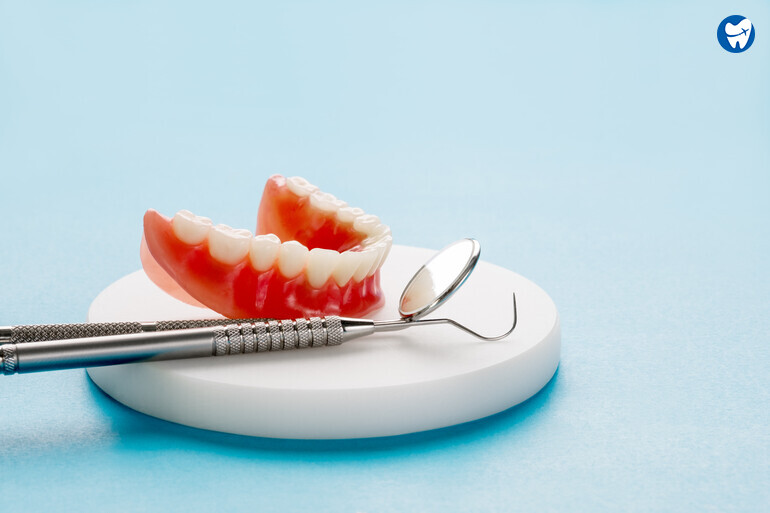
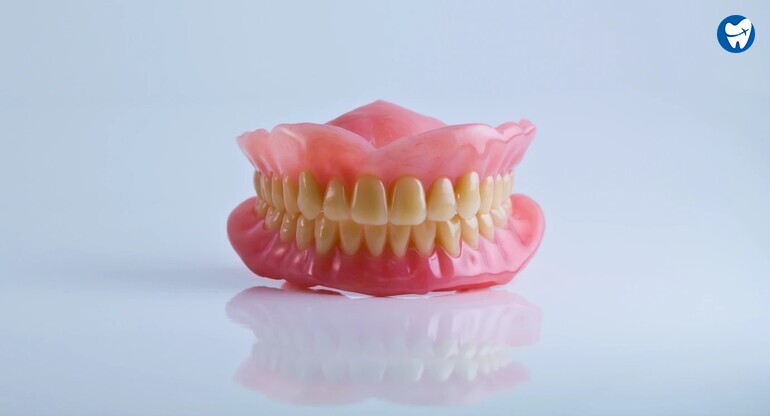
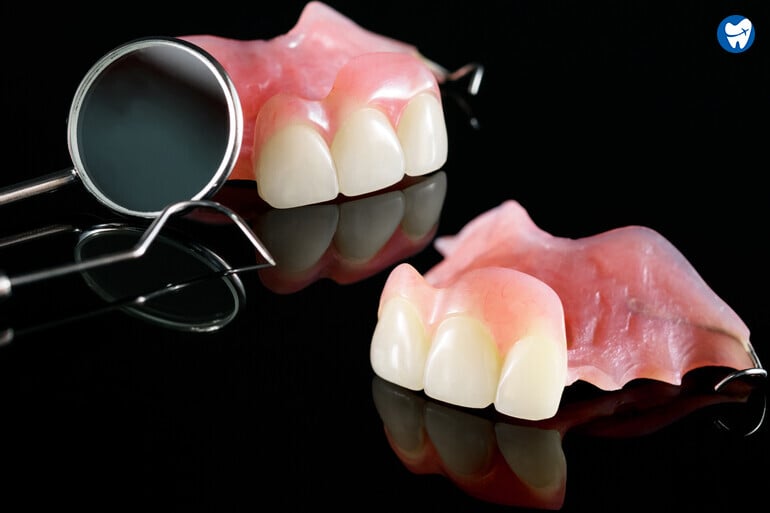
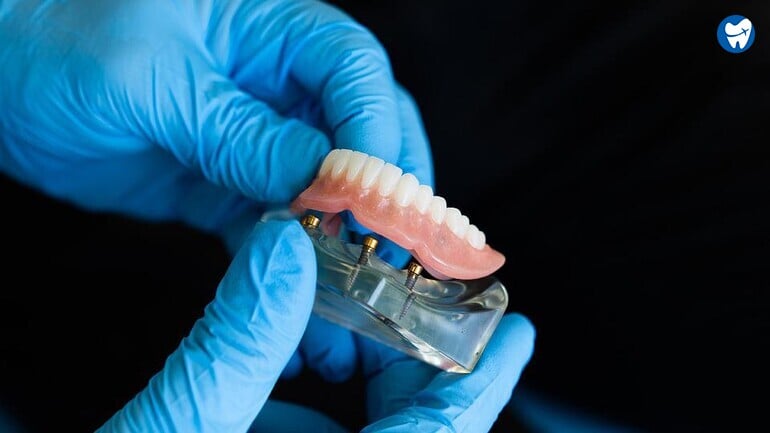
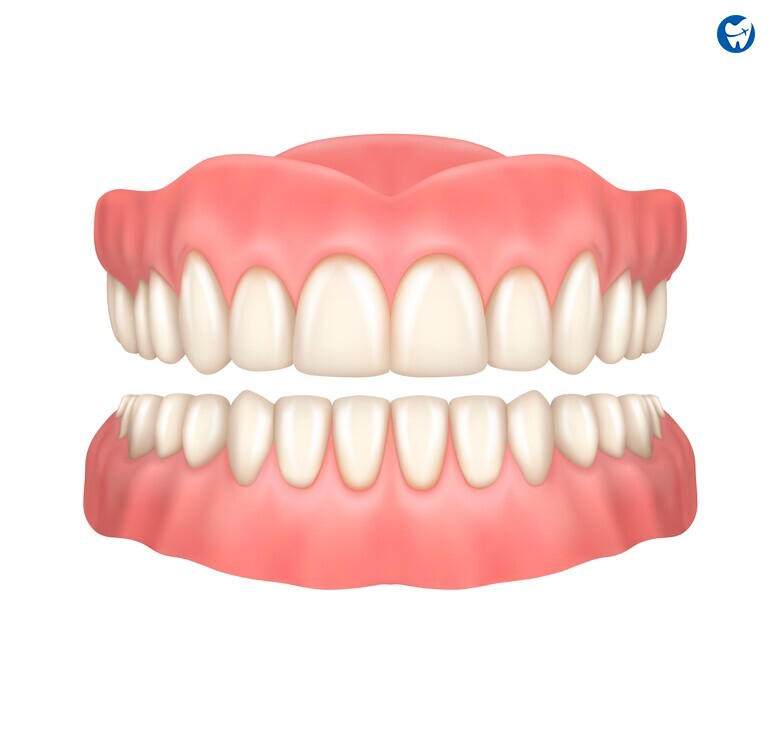
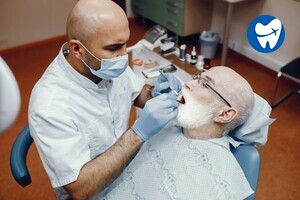
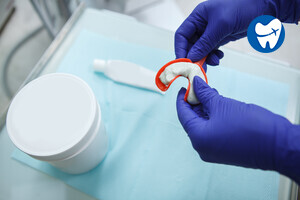
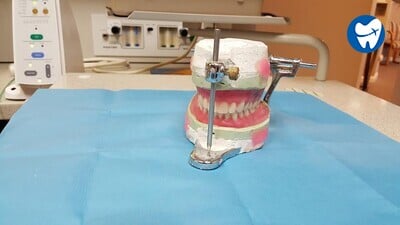
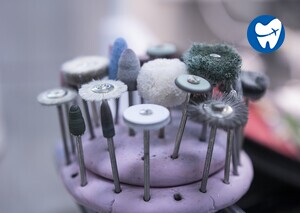

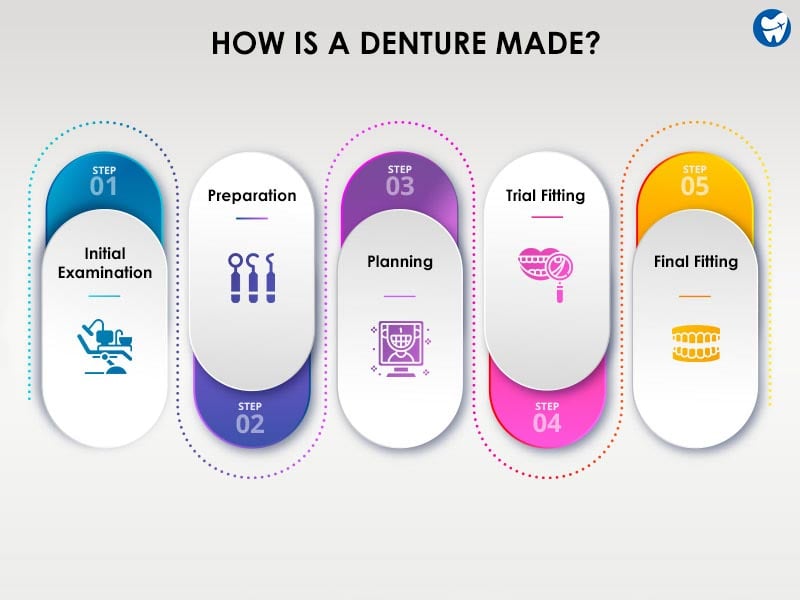 Denture Process
Denture Process